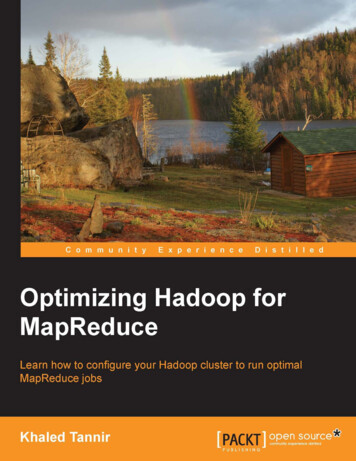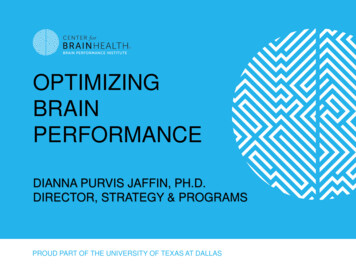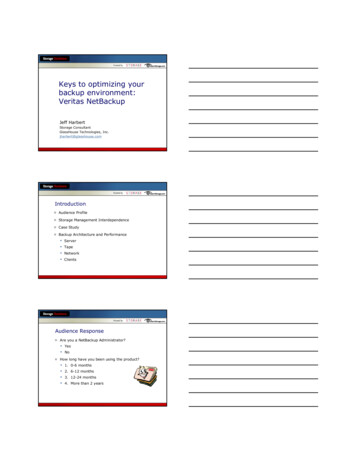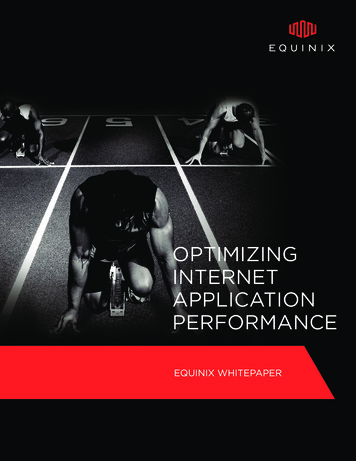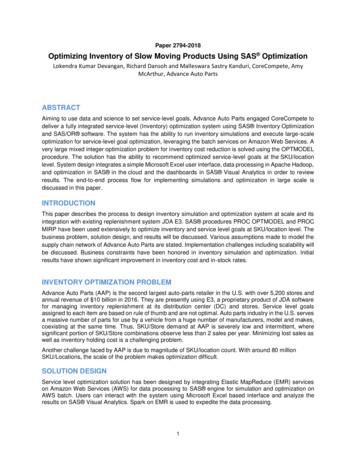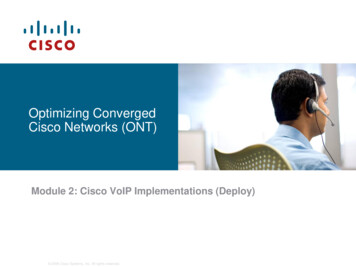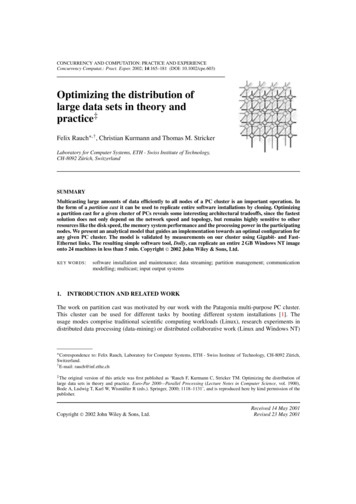
Transcription
CONCURRENCY AND COMPUTATION: PRACTICE AND EXPERIENCEConcurrency Computat.: Pract. Exper. 2002; 14:165–181 (DOI: 10.1002/cpe.603)Optimizing the distribution oflarge data sets in theory andpractice‡Felix Rauch ,† , Christian Kurmann and Thomas M. StrickerLaboratory for Computer Systems, ETH - Swiss Institute of Technology,CH-8092 Zürich, SwitzerlandSUMMARYMulticasting large amounts of data efficiently to all nodes of a PC cluster is an important operation. Inthe form of a partition cast it can be used to replicate entire software installations by cloning. Optimizinga partition cast for a given cluster of PCs reveals some interesting architectural tradeoffs, since the fastestsolution does not only depend on the network speed and topology, but remains highly sensitive to otherresources like the disk speed, the memory system performance and the processing power in the participatingnodes. We present an analytical model that guides an implementation towards an optimal configuration forany given PC cluster. The model is validated by measurements on our cluster using Gigabit- and FastEthernet links. The resulting simple software tool, Dolly, can replicate an entire 2 GB Windows NT imageonto 24 machines in less than 5 min. Copyright 2002 John Wiley & Sons, Ltd.KEY WORDS :software installation and maintenance; data streaming; partition management; communicationmodelling; multicast; input output systems1. INTRODUCTION AND RELATED WORKThe work on partition cast was motivated by our work with the Patagonia multi-purpose PC cluster.This cluster can be used for different tasks by booting different system installations [1]. Theusage modes comprise traditional scientific computing workloads (Linux), research experiments indistributed data processing (data-mining) or distributed collaborative work (Linux and Windows NT) Correspondence to: Felix Rauch, Laboratory for Computer Systems, ETH - Swiss Institute of Technology, CH-8092 Zürich,Switzerland.† E-mail: rauch@inf.ethz.ch‡ The original version of this article was first published as ‘Rauch F, Kurmann C, Stricker TM. Optimizing the distribution oflarge data sets in theory and practice. Euro-Par 2000—Parallel Processing (Lecture Notes in Computer Science, vol. 1900),Bode A, Ludwig T, Karl W, Wismüller R (eds.). Springer, 2000; 1118–1131’, and is reproduced here by kind permission of thepublisher.Copyright 2002 John Wiley & Sons, Ltd.Received 14 May 2001Revised 23 May 2001
166F. RAUCH, C. KURMANN AND T. M. STRICKERand computer science education (Windows NT, Oberon). For best flexibility and maintenance, such amultiuse cluster must support the installation of new operating-system images within minutes.The problem of copying entire partitions over a fast network leads to some interesting tradeoffs inthe overall design of a PC cluster architecture. Our cluster nodes are built from advanced componentssuch as fast microprocessors, disk drives and high speed network interfaces connected via a scalableswitching fabric. Yet it is not obvious which arrangement of the network or which configuration of thesoftware results in the fastest system to distribute large blocks of data to all the machines of the cluster.After in-depth analytical modelling of network and cluster nodes, we create a simple, operatingsystem independent tool that distributes raw disk partitions. The tool can be used to clone any operatingsystem. Most operating systems can perform automatic installation and customization at startup and acloned partition image can therefore be used immediately after a partition cast completes.For experimental verification of our approach we use a meta cluster at our university (ETH Zürich)that unites several PC clusters, connecting their interconnects to a dedicated cluster backbone. Thiscluster testbed offers a variety of topologies and networking speeds. The networks include someGigabit networking technology like SCI [2,3] and Myrinet [4] with an emphasis on Fast and GigabitEthernet [5]. The evaluation work was performed on the Patagonia sub-cluster of 24 Dell 410 DesktopPCs configured as workstations with keyboards and monitors. The Intel based PC nodes are builtaround a dual Pentium II processor configuration (running at 400 MHz) and 256 MB SDRAM memoryconnected to a 100 MHz front side bus. All machines are equipped with 9 GB Ultra2 Cheetah SCSIhard-disk drives which can read and write a data stream with more than 20 MB s 1 .Partition cloning is similar to general backup and restore operations. The differences between logicaland physical backup are examined in [6]. We wanted our tool to remain operating-system and filesystem independent and therefore we work with raw disk partitions ignoring their filesystems and theircontent.Another previous study of software distribution [7] presents a protocol and a tool to distribute datato a large number of machines while putting a minimal load on the network (i.e. executing in thebackground). The described tool uses unicast, multicast and broadcast protocols depending on thecapabilities and the location of the receivers. The different protocols drastically reduce the networkusage of the tool, but also prevent the multicast from reaching near maximal speeds.Pushing the protocols for reliable multicast over unreliable physical network towards higher speedsleads to a great variation in the perceived bandwidth, even with moderate packet loss rates, as shownin [8]. Known solutions for reliable multicast (such as [9]) require flow-control and retransmissionprotocols to be implemented in the application. Most of the multicast protocol work is geared todistribute audio and video streams with low delay and jitter rather than to optimize bulk data transfersat a high burst rate.The model for partition cast is based on similar ideas presented in the throughput-oriented copytransfer model for MPP computers [10].A few commercial products are available for operating system installation by cloning, such asNorton Ghost [11], ImageCast [12] or DriveImagePro [13]. All these tools are capable of replicating awhole disk or individual partitions and generating compressed image files, but none of them can adaptto different networks or the different performance characteristics of the computers in PC clusters.Commercial tools also depend on the operating- and the file system, since they use knowledge of theinstalled operating system and file systems to provide additional services such as resizing partitions,installing individual software packages and performing customizations.Copyright 2002 John Wiley & Sons, Ltd.Concurrency Computat.: Pract. Exper. 2002; 14:165–181
DISTRIBUTION OF LARGE DATA SETS167Figure 1. An active node (left) with an in-degree of 1 and an out-degreeof 2 as well as a passive node (right) with an in- and out-degree of 3.An operating system independent open source approach is desired to support partition cast formaintenance in Beowulf installations [14]. Other applications of our tool could include presentation-,database- or screen-image cast for new applications in distributed data mining, collaborative work orremote tutoring on clusters of PCs. An early survey about research in that area including video-cast forclusters of PCs was done in the Tiger project [15].2. A MODEL FOR PARTITION-CAST IN CLUSTERSIn this section we present a modelling scheme that allows to find the most efficient logical topology todistribute data streams.2.1. Node typesWe divide the nodes of a system into two categories, active nodes which duplicate a data stream andpassive nodes which can only route data streams. The two node types are shown in Figure 1.Active node. A node which is able to duplicate a data stream is called an active node. Active nodesthat participate in the partition cast store the received data stream on the local disk.An active node has at least an in-degree of 1 and is capable of passing the data stream further to oneor more nodes (out-degree) by acting as a T-pipe.Passive node. A passive node is a node in the physical network that can neither duplicate nor store acopy of the data stream. Passive nodes can pass one or more streams between active nodes in thenetwork.Partition cast requires reliable data streams with flow control. Gigabit Ethernet switches only provideunreliable multicast facilities and must therefore be modelled as passive switches that only routeTCP/IP point-to-point connections. Incorporating intelligent network switches or genuine broadcastmedia (like Coax Ethernet or Hubs) could be achieved by making them active nodes and modellingthem at the logical level. Such is an option for expensive Gigabit ATM switches that feature multicastcapability on logical channels with separate flow control or for simple multicast enhanced switches. Inthe later case a special end-to-end multicast protocol is used to make multicast data transfers reliable.Copyright 2002 John Wiley & Sons, Ltd.Concurrency Computat.: Pract. Exper. 2002; 14:165–181
168F. RAUCH, C. KURMANN AND T. M. STRICKERCOPS16 NodesPatagonia8 Nodes.COPS Cluster16 NodesCabletron CabletronSSR 8000 SSR 8600.Fast EthernetGigabit Ethernet.Cabletron CabletronSSR 8600 SSR 9000Math./Phys.Beowulf192 NodesLinneus16 NodesFigure 2. Physical network topologies of the ETH meta-cluster (left) andthe simple sub-cluster with one central switch (right).2.2. Network typesThe different subsystems involved in a partition-cast must be specialized to transfer long data streamsrather than short messages. Partitions are fairly large entities and our model is therefore purelybandwidth-oriented. We start our modelling process by investigating the topology of the physicalnetwork determing and recording the installed link and switch capacities.Physical network. The physical network topology is a graph given by the cables, nodes and switchesinstalled. The vertices are labeled by the maximal switching capacity of a node, the edges by themaximal link speeds.The model itself captures a wide variety of networks including hierarchical topologies with multipleswitches. Figure 2 shows the physical topology of the meta-cluster installed at ETH Zürich and thetopology of our simple sub-cluster testbed. The sub-cluster testbed is built with a single central GigabitEthernet switch with full duplex point-to-point links to all the nodes. The switch has also enoughFast Ethernet ports to accommodate all cluster nodes at the low speed. Clusters of PCs are normallybuilt with simple and fast layer-2 switches like our Cabletron Smart Switch Routers. In our case thebackplane capacity for a 24 port switch is at 4 GB s 1 and never results in a bottleneck.Our goal is to combine several subsystems of the participating machines in the most efficient way foran optimal partition-cast, so that the cloning of operating system images can be completed as quicklyas possible. We therefore define different setups of logical networks.Logical network. The logical network represents a connection scheme, that is embedded into aphysical network. A spanning tree of TCP/IP connections routes the stream of a partition cast toall participating nodes. Unlike the physical network, the logical network must provide reliabletransport and flow control over its channels.Copyright 2002 John Wiley & Sons, Ltd.Concurrency Computat.: Pract. Exper. 2002; 14:165–181
DISTRIBUTION OF LARGE DATA SETS169SSSSSSFigure 3. Logical network topologies (top) describing logical channels (star, n-ary spanning tree, multi-drop-chain)and their embedding in the physical networks.Star. A logical network with one central server, that establishes a separate logical channel to all nother nodes. This logical network suffers heavy congestion on the outgoing link of the server.n-ary spanning tree. Eliminates the server bottleneck by using an n-ary spanning tree topologyspanning all nodes to be cloned. This approach requires active T-nodes which receive the data,store it to disk and pass it further to up to n next nodes in the tree.Multi-drop-chain. A degenerated, specialized tree (unary case) where each active node stores a copyof the stream to disk and passes the data to just one further node. The chain is spanning all nodesto be cloned.Figure 3 shows the above described topologies as well as their embedding in the physical networks.We assume that the central switch is a passive node and that it cannot duplicate a partition cast stream.2.3. Capacity modelOur model for maximal throughput is based on capacity constraints expressed through a number ofinequalities. These inequalities exist for active nodes, passive nodes and links, i.e. the edges in thephysical net. As the bandwidth will be the limiting factor, all subsystems can be characterized by themaximal bandwidth they achieve in an isolated transfer. The extended model further introduces somemore constraints e.g. for the CPU and the memory system bandwidth in a node (see Section 2.5).Reliable transfer premise. We are looking for the fastest possible bandwidth with which we canstream data to a given number of active nodes. Since there is flow control, we know that thebandwidth b of the stream is the same in the whole system.Copyright 2002 John Wiley & Sons, Ltd.Concurrency Computat.: Pract. Exper. 2002; 14:165–181
170F. RAUCH, C. KURMANN AND T. M. STRICKERPassive NodeSwitching Capacity4 GByte/sPhysical Link125 MByte/s2 Logical Channelsb 62.5 MByte/s eachdue to edge capacity4 Streamsb 1 GByte/s eachdue to node capacityActive NodeSwitching Capacityb 30 MByte/s3 Streamsb 10 MByte/s eachdue to node capacityFigure 4. Edge capacities exist for the physical and logical network, nodecapacities for each in- and out-stream of a node.Fair sharing of links. We assume that the flow control protocol eventually leads to a stable systemand that the links or the nodes, dealing with the stream, allocate the bandwidth evenly and at aprecise fraction of the capacity.Both assumptions hold in the basic model and will be slight
Norton Ghost [11], ImageCast [12] or DriveImagePro [13]. All these tools are capable of replicating a whole disk or individual partitions and generating compressed image files, but none of them can adapt to different networks or the different performance characteristics of the computers in PC clusters. Commercial tools also depend on the operating- and the file system, since they use .
